Here you’ll find defensive basketball plays utilizing the zone defense.
Just follow the key to understand the diagrams and follow along with the text descriptions.
Practice, practice, practice until you can run these plays in your sleep. Only after hours and hours of perfect practice will you be ready to DOMINATE!
Key
Red Triangle = Defenders
Blue Circle = Offensive Players
Red Dotted Arrow = a pass
Black Straight Arrow = player movement
Each zone defense play is separated by a horizontal line running across the page.
“Zone defenses use basic principles to force opponents into either full-court, three-quarter-court, or half-court areas in order to upset their offense” – Glenn Brown
1-2-2 Zone Defense
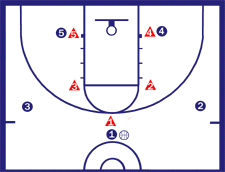
Start with 1-2-2 zone defense pressure alignment.
D1 goes to mid-court to pressure O1 and the ball.
D2 & D3 should be positioned at elbows to stop any penetration.
D4 & D5 are in low post.
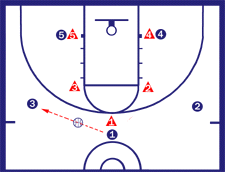
In this ex., O1 passes to O3.
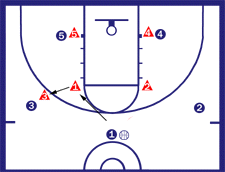
D3 should slide over and cover O3 man-to-man as D1 takes up position at high post.
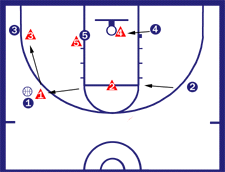
In this zone defense ex., O3 dishes back to O1 and cuts to corner as O1 slides over to wing position. D3 goes with O3, D1 plays man on O1.
D2 & D4 should be aware of O2 & O4, but D2 slides over to middle of foul line and D4 moves to middle of key for possible rebound. D5 guards O5 in low post.
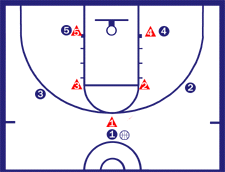
If O1 dribbles back to top of key and O3 returns to wing, the D will adjust back into original starting zone defense set-up.
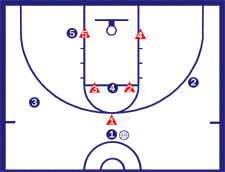
In this case, O4 tries to get position in high post so D2 & D3 should close in and cover.
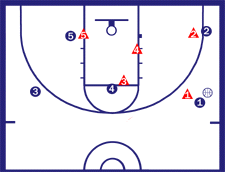
O2 cuts to corner & O1 moves out to wing. D2 should take away pass to O2 as D3 covers high post player D4 takes away any penetration through key.
20-2-3 Zone Defense
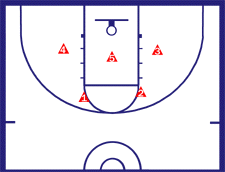
Here your guards are ready to defend the 3 point line and your “3” part of the zone should be lined up with the first mark above the block. Use man-to-man principles when playing zone defense.
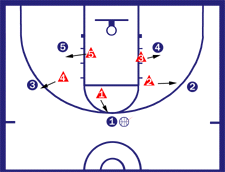
The zone defense must match-up as the offense comes down court. The defense must be talking to each other at all times.
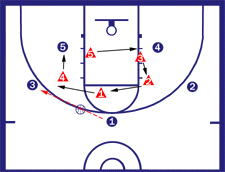
If player 1 passes the ball to player 2 the defense would stay with their matchups, but if 1 passes to 3 then BUMPING begins. Defensive player 1 would bump 4 down. 4 does not leave until 1 tells him to. BUMPING will occur only when a “back line” defender is out guarding a perimeter player.
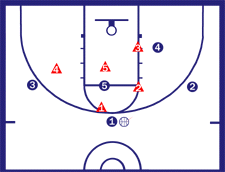
In this situation the offense has a high post 5. Defense 5 will match-up with 5. D1 and D2 will help D5 by trying to get a hand in any passing lane to 5. D5 will keep 5 as far away from the basket as possible on any shots taken by the offense.
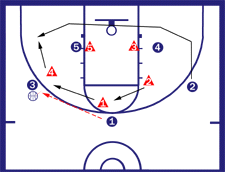
If the offense sends a cutter through, it is very crucial that the defenders communicate. D2 must yell “cutter” and he must bump or slow down the cutter. D3 and D5 will also try to slow down the cutter. D1 bumps D4 down, and D2 slides up. D4 will match up with 2 in the corner.
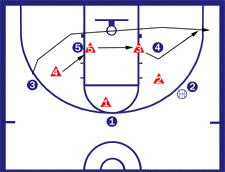
If they send the cutter to the opposite side. D2 stays put. D4 yells “cutter” and slows down 3’s progress. D3 will match-up with 3 on the perimeter, D5 will slide over and D4 takes the opposite low post (5).
23 Tight Zone Defense
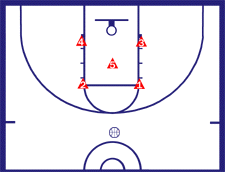
If the ball is in the middle, D1 and D2 straddle the circle line no more than 2ft. apart with arms extended. D3 and D4 straddle the foul line 1ft above block. D5 lines up on the broken circle to stop penetration to the high post.
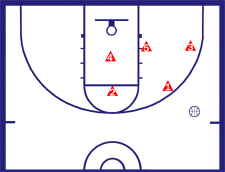
If the ball is on the left side, D1 slides left to protect the high post. D2 assists with high post and stops the return pass to the weak side. D3 moves up the lane with the ball, cuting off the passing lanes inside of the extended foul line. D4 covers the lane in front of basket. D5 positions halfway to assist with the high post and cuts off any pass to low post.
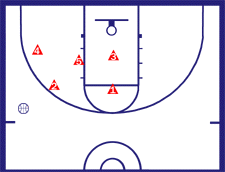
With the ball in the right lane, D2 slides left to protect the high post, D1 assists with the high post and stops the return pass to weak side. D4 moves up the lane with the ball and cuts off the passing lanes inside of the extended foul line. D3 covers the lane in front of basket. D5 goes to the halfway position to assist with the high post and to cut off any pass to the low post.
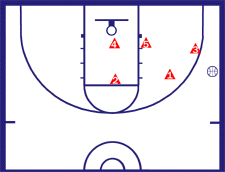
With the ball on the left wing, D1 is now responsible for the pass to the high post. D2 moves behind the post and covers the lob pass. D3 moves up to the extended foul line and plays the outside shoulder and cuts off passing lanes inside of the extended foul line. D4 protects the basket and weak side rebounds. D5 covers the low post pass.
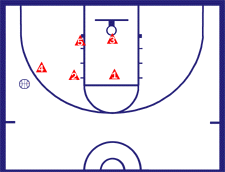
With the ball on the right wing, D2 is responsible for the high post pass. D1 moves behind the post to cover the lob pass. D4 moves up to the extended foul line and plays the outside shoulder in order to cut off the inside passing lanes. D3 protects the basket and weak side rebound. D5 covers the low post pass.
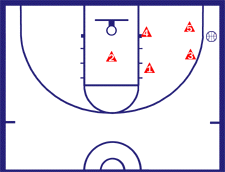
Now the ball is in the left corner. If the offense dribbles out, D3 automatically doubles along with D5. D1 prevents the high post pass. D2 covers the lane and must rebound the weak side. D3 prevents the pass from the corner. D4 prevents the low post pass. D5 protects the baseline and traps in corner.
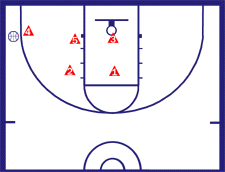
Now the ball is in the right corner. If the offense dribbles out, D4 automatically doubles with D5. D2 prevents the high post pass. D1 covers the lane and must rebound the weak side. D4 prevents the pass from corner. D3 prevents the low post pass. D5 protects the baseline and traps in corner.
2 – 3 Basic Defense
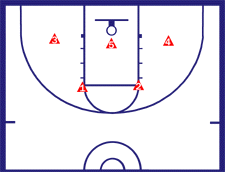
The 2 – 3 basic defense promotes teamwork allowing it to work for most teams. Start by lining up D3, D4 and D5 along the bottom and D1 and D2 up top.
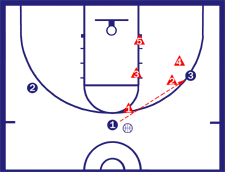
If the ball gets passed to the offensive player positioned at the right wing, the defense shifts to the right. Every defensive player moves to the right. D2 and D4 play the ball now in the wing. D5 covers the low post, while D3 covers the high post. D1 defends against the pass.
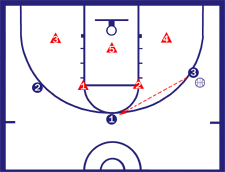
When the ball rotates back up top, the defense returns to their beginning positions. Now the guards D1 and D2 attack the ball.
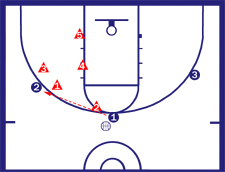
The concept is the same if the ball goes the opposite direction the left side. The whole defense rotates over. Now D3 and D1 attack the ball at the wing. D2 slides over to cover the pass and D4 and D5 take the high post and the low post respectively.
As you can see wherever the ball goes the 2 – 3 formation stays true to form. There will always be two defenders on the ball with 3 defenders backing them up.
As you can see, the idea behind zone defense is pressure. Pressure the ball constantly and frustrate ’em!
